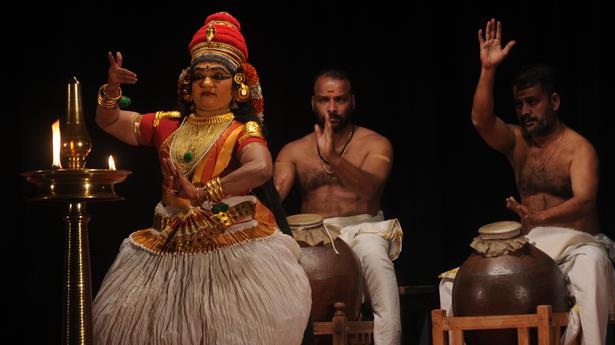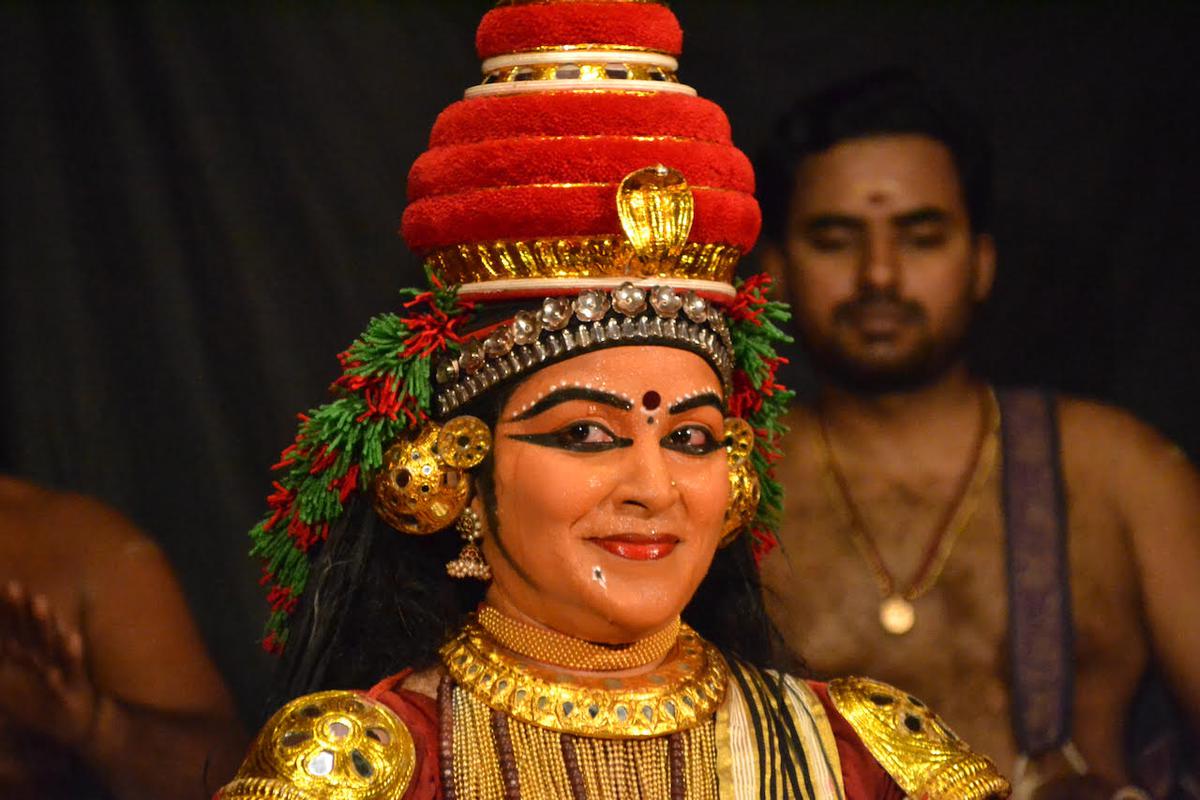
Women take centre stage in Koodiyattam
Women seem to be taking over the once male-dominated Koodiyattam stage as they reclaim traditional roles and choreograph new productions
Women seem to be taking over the once male-dominated Koodiyattam stage as they reclaim traditional roles and choreograph new productions
There is a new creative energy flowing on the male-centric Koodiyattam stage. And ironically, almost all of it is being led by women. Usha Nangiar is performing the entire Sreekrishnacharitam and recording the 30-plus episodes for archives. Kalamandalam Sangeetha has choreographed a new play based on Amba and staged its first part a few months ago. Kalamandalam Sindhu is on a mission to perform the entire Sreeramacharitam with about 40 episodes. Kalamandalam Krishnendu recently performed a segment from a new play on Parvathi in New Delhi. Kapila Venu has premiered a new production based on Devi Mahatmyam. Dr. Indu G is on course to complete Gita Govinda in about 20 parts.
Till about 40 years ago there were only three or four women characters in Koodiyattam plays; and even they had only a symbolic presence, sparse dialogues and hardly any scope for detailed abhinaya. They were retained only because these characters were essential for the progress of the story. Today the repertoire is rich both in Nangiarkoothu, a standalone solo act for women, and in Koodiyattam plays.
This resurgence is by no means an accident. It is the result of a lot of efforts by many women performers to regain their place in the Koodiyattam arena. Historically women characters in Koodiyattam were always performed by women even a thousand years ago, a practice not seen anywhere else in the world. But over time their roles were cut, and their importance reduced to mere temple rituals.
Strong foundation
The foundation for today’s strong female presence was laid by Kalamandalam Girija and Kalamandalam Sailaja, disciples of the late Painkulam Rama Chakyar, who brought this art form out of the temple precincts. This initial impetus was further strengthened by Usha Nangiar and the late Margi Sathi. They not only reclaimed lost territory but contributed new pieces to expand the Nangiarkoothu and Koodiyattam repertoire for women. Today the field is rich with several Nangiarkoothu artistes.

Kalamandalam Sangeetha
| Photo Credit: Achuthan T.K.
The most important section in Koodiyattam is the nirvahanam or retrospective segment where the actor describes the events of the past in a solo act, which is a potent vehicle to showcase one’s histrionic talent and imagination. But there were no nirvahanam segments in practice for women till the year 2000.
In the preface of her book Abhinetri, Usha Nangiar explains her frustration as a student: “Many a time I have stood transfixed, a painful longing to consume myself in the fever of performance as I beheld the Koodiyattam stages set ablaze by the regal Bali, haughty yet majestic Ravana, or Laksmana and Sugriva, the embodiments of sibling bonding. The anguish of being a woman who couldn’t get such roles was eating me.”
New pool of talent
According to Usha, who is largely instrumental in reclaiming lost roles and bringing new female characters to the stage, a new era for women started in 1980 when her guru expressed his willingness to teach women. Many came forward to learn after Kerala Kalamandalam started offering Koodiyattam courses in 1965. Koodiyattam, which hitherto belonged exclusively to the Chakyar and Nambiar communities, discovered a new pool of talent.
Usha says her research turned up references to nirvahanam of female characters in several plays but the performance texts were not found. Usha, who had shlokas written for Mandodari’s nirvahanam in Asokavanikankam, also brought the characters of Draupadi, Sakuntala and Ahalya on stage. She thinks much more research needs to be done to explore the potential for female roles in plays such as Naganandam and Tapatisamvaranam. Usha also says women artistes are today more interested in performing the nirvahanam segment because the solo act offers more freedom and scope for abhinaya.

Kalamandalam Sindhu
| Photo Credit: MAHINSHA S
Kalamandalam Sindhu, who is performing the entire Sreeramacharitam Nangiarkoothu, agrees. She finds it challenging and stimulating to interpolate new acting segments into the performance text and look for new interpretations. Such opportunities were not available when she graduated more than 20 years ago, in Koodiyattam. But she was forced to teach Mohiniyattam and other dance forms for survival.
Kapila Venu
| Photo Credit: Special Arrangement
Today there are comparatively more avenues to perform, and Koodiyattam artistes enjoy some amount of popularity.
Dr. Indu G, who has choreographed and performed Uttararamacharitam and is currently presenting Jayadeva’s Gita Govinda as Nangiarkoothu, says Malayalam literature is the source of her inspiration. For example, she took up Gita Govinda because its poetry appealed to her . Also, as a Koodiyattam artiste she wanted to explore the limits of presenting sringara on stage.
Indu recently performed Ravana’s tapassattam or penance as part of Lalita’s nirvahanam in Soorpanakankam. Though this episode has been performed by Usha and Sindhu as part of different plays, Indu’s attempt was to show that in Koodiyattam there is scope to show the same incident with different interpretations and detailing.

Indu G
| Photo Credit: Achuthan T.K.
Kalamandalam Sangeetha of Kriya Natyasala, who is working on her new play Ambaprasasthi (Amba’s fame) by Prof. Ennazhi Rajan, chose not to focus only on the nirvahanam section. “I had the option to do a two-hour Nangiarkoothu based on Amba. But Koodiyattam is a multi-dimensional art form, and I wanted the experience of doing a play from scratch with the three segments of Purappad, Nirvahanam and Koodiyattam.
“Doing a modern play offered a completely new experience compared to doing a Kalidasa or Bhasa play. Sanskrit language has changed over the years. It has been a very demanding and rewarding experience for me to write the kramadeepika or stage manual and the attaprakaram or the actor’s manual.”
Sangeetha, and her husband Ratheesh Bhas, a Koodiyattam percussionist on the mizhavu, are now engaged in translating the actor’s manual onto the performance stage. “The entire play, to be performed over five days, isn’t complete yet. I have performed only the retrospective section.”
New challenges
Most of these women artistes are undertaking these projects at their own expense. Sindhu says the problem that Koodiyattam confronts today are limited performance opportunities, lack of financial security and a failure to draw youngsters. She is performing the entire Uttararamacharitam to fulfil her promise to her late guru Margi Sathi. Help comes from co-artistes, who perform for free and a handful of benefactors, who help meet the expenses.
Sugreeva, the agent of Sumbha and Nisumbha, comes to Parvathi and says they want to marry her. Parvathi says she is willing but in her childhood she made a bet with her friends that she will marry only the man who defeats her in battle. She asks Sugreeva to tell his bosses to come fast and defeat her. Sugreeva is not pleased and leaves.
For now, Koodiyattam is in no imminent danger as there are many highly talented and committed artistes, both men and women, to keep it going. Though it must be acknowledged that the lead is at present being taken by women.
The author, a retired journalist, writes on Kerala’s performing arts.
Stay connected with us on social media platform for instant update click here to join our Twitter, & Facebook
We are now on Telegram. Click here to join our channel (@TechiUpdate) and stay updated with the latest Technology headlines.
For all the latest Entertainment News Click Here
For the latest news and updates, follow us on Google News.

